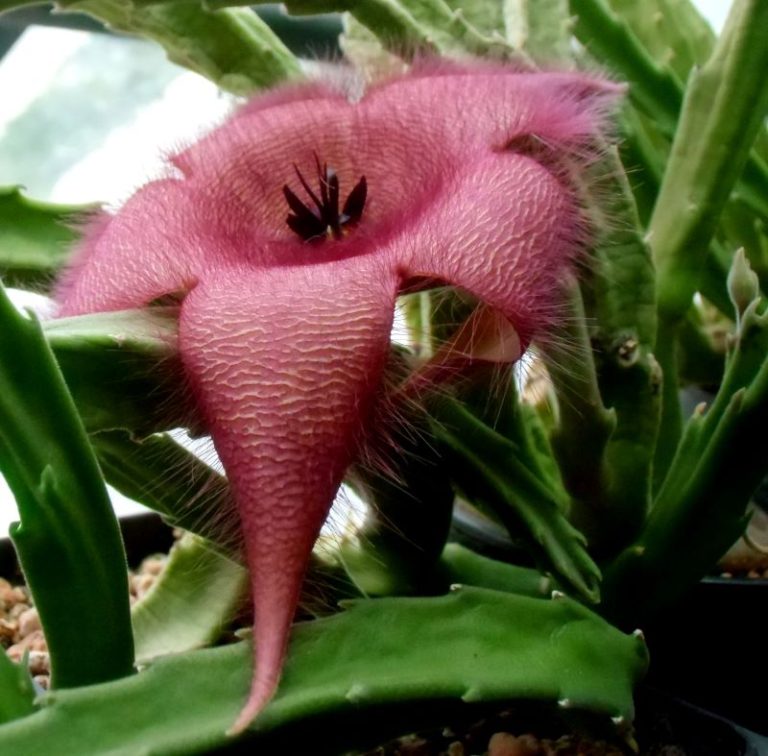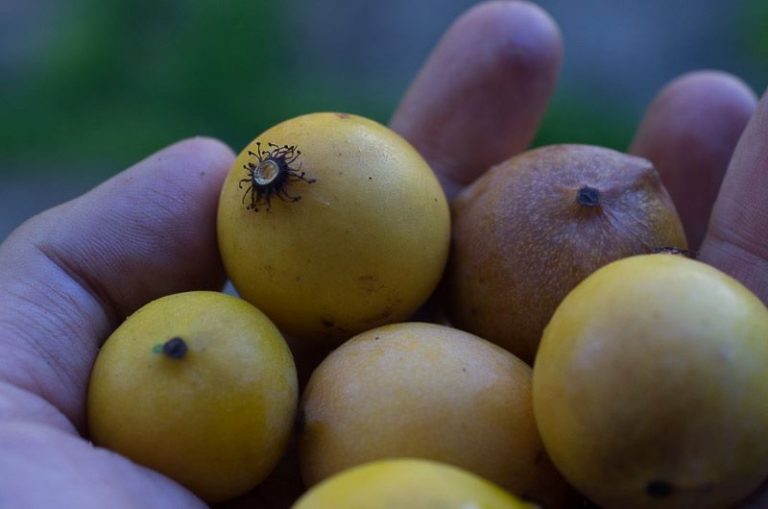How to Grow Dragonfruit

Are you thinking about adding dragonfruit to your Florida garden? This exotic-looking fruit is surprisingly easy to grow, as long as you have a little bit of know-how and live in the right climate.
Is Dragonfruit a Cactus?
Yes, dragonfruit is a cactus native to Mexico, Guatemala, Costa Rica, and other parts of Central and South America.
Dragonfruit got its name from the leathery texture of its skin. It’s also known as pitaya, pitahaya, and the strawberry pear.
There are a lot of different varieties of dragon fruitavailable to grow. Depending on the variety, dragon fruit can have white, pink, or red flesh.
Dragonfruits are a night-blooming cereus. This is a group of cacti species that flower at night.
Dragonfruit flowers are absolutely incredible. These white flowers are fragrant and among the biggest blooms in the world. Each flower only opens once, usually around midnight but as late as early morning. That gives the dragonfruit flower only one chance at pollination.
 |
| Credit: Scot Nelson |
Self-Pollinating vs. Cross-Pollinating
When choosing a dragonfruit variety, it’s important to know whether the variety is self-pollinating or cross-pollinating.
If a dragonfruit is the self-pollinating type, this means that you only need one plant to produce fruits. The dragonfruit will pollinate itself.
If a dragonfruit is the cross-pollinating type, then you will need at least two different varieties of dragonfruit cacti. One variety needs to pollinate the other in order to produce fruit.

Although creatures like moths, bats, and bees will pollinate your dragonfruit, I recommend hand-pollinating. Going out in the dead of night to hand-pollinate feels like a little adventure and will increase your chances of a good dragonfruit haul.
This video will show you how to cross-pollinate your dragonfruit:
Where Will Dragonfruit Grow?
Dragonfruit is a tropical cactus. They grow outside year-round in USDA zones 9 through 11, but those in zone 9 may need to cover their cacti during the coldest parts of the year to protect them from frost.
Dragonfruit needs a trellis whether you grow it in the ground or in a container. It’s a big, crawling plant that can live up to 30 years. If you’re a gardener above zone 9 and are planning on growing a dragonfruit, plan ahead. While you can bring it inside during the winter, it can be difficult because the dragonfruit, trellis, and container are heavy and hard to move.
This cactus doesn’t like extreme temperatures. Long periods of time in 31°F weather can kill a dragonfruit, but they also do poorly if temperatures reach 100°F. Somewhere between 65????F-77°F is perfect.
Dragonfruit is a cacti that likes full sun. I have my dragonfruit in a little bit of shade and they are growing more slowly than I’d like. If I were to re-plant them, I’d put them in a spot that gets more sun.
What Kind of Soil Should You Use When Growing Dragonfruit?
Dragonfruit isn’t too picky about the soil it’s grown in as long as it’s well-draining.
If you’re growing in a container, then equal parts potting mix, compost, and perlite should work well.
I plant my dragonfruit directly in the ground, with a few handfuls of compost thrown into the hole to give my dragonfruit an extra boost. The sandiness of my central Florida soil is great for drainage, but lacks in nutrients.
Dragonfruit Watering
Dragonfruit needs a little more water than the typical cacti, but only during certain parts of the year. To produce the most fruit, dragonfruit needs a dry period and a wet period.
During fall and winter, you should keep your dragonfruit a little dry. During spring and summer, your cactus will start to bloom – this is when you should water more often.
Your dragonfruit will need about an inch of water per week. Do the touch test – if the soil is dry to the touch, then it’s time to water. Don’t let your dragonfruit get too soggy, otherwise you could be fighting root rot in the future.
How to Grow Dragonfruit from Cuttings
Growing from cuttings is the most common way to grow dragonfruit. It’s also pretty straightforward:
- Cut off a piece of new growth from the dragonfruit plant about five or six inches long.
- Cut off the bottom tip to expose the inside of the cacti.
- Set the cutting aside for three to seven days to allow the bottom to scab over.
- Plant the cutting about two inches deep in a container or directly in the ground.
How to Grow Dragonfruit from Seeds
You can grow dragonfruit from the seeds inside a fruit that you get from the grocery store, but it’ll take a really long time (5-7 years!) for you to get fruit.
If you’re patient and want to try your hand at growing a dragonfruit from seed, follow these steps:
Put well-draining potting soil in a small to medium-sized container.
- Scoop out the inside of a dragonfruit.
- Wash the flesh from the seeds and put the seeds on a damp paper towel overnight.
- Plant the seeds shallowly into your container. Your seeds should be about a quarter of an inch below the soil.
- Water in your dragonfruit seeds. Keep your container moist but not soggy.
- Thin your plants out as they grow, and gradually step them up into larger containers. A full-grown dragonfruit will need a 20-25 gallon container.
Trellising Your Dragonfruit

Dragonfruit is a vertical climber, so you’ll need to build a trellis for your cactus to grow up. Dragonfruit plants can get pretty heavy, so whatever trellis you chose needs to be sturdy.
We used an 8 foot long agricultural 4×4 for the main vertical base of our trellis. At the top, we screwed in two pieces of 1×2 formed in an X shape. We buried the trellis about a foot into the ground so that wind or the weight of the dragonfruit won’t knock it over.
You’ll have to train your dragonfruit to grow vertically. I use zipties to hook the cactus to the trellis — just be careful not to cinch the zipties too tight.

You can put more than one dragonfruit cutting at the base of your trellis, as long as you give them a little bit of space. A few inches between each cutting is fine.
If your dragonfruits get unruly, it’s time to prune. Your cactus will branch off from the main stem as it gets bigger. Cut off any excess pieces of the cactus where it connects to the stem. You can re-plant these as cuttings, or give them to a friend to plant in their own garden.
You want as much airflow as possible in between your dragonfruit growth to let the cacti dry out. Airflow is important in preventing fungal disease.
Dragonfruit Care
Some common dragonfruit pests include mites, thrips, aphids, ants, scale, mealybugs, and slugs.
Dragonfruit is especially prone to root rot, rust, and other fungal diseases. Proper watering, pruning, and spacing will help keep your dragonfruit healthy.
Regular pruning will also increase your fruit production.
How Long Does it Take for a Dragonfruit to Fruit?
A dragonfruit can start flowering as early as six months, but it can take up to two years to bear fruit.
Dragonfruits live up to 30 years and will consistently produce fruit until it’s about 20. After that, it should still fruit, but not as often.
Dragonfruit cacti will bear fruit from summer through fall, and can have five to six waves of fruit through the season. Dragonfruits are extremely generous – one three to four year old dragonfruit can produce up to 220lbs of fruit per year!
You can tell when a dragonfruit is ripe by the color of its skin. With most varieties, your fruit will start off green and turn bright red when it’s ready to be picked. Dragonfruit does not ripen after it’s picked, so don’t harvest it too early.
How to Prepare and Eat a Dragonfruit
Preparing your dragonfruit is super simple – just cut it in half and scoop out the insides with a spoon. The black seeds inside are eaten along with the flesh.
The skin is not edible, but some people use them as a plating element since the skin is so exotic-looking.
Dragonfruit is tasty eaten on its own, or you can use it in smoothies, desserts, or salads.
Dragonfruit has a lot of health benefits:
- Low calorie
- Rich in antioxidants
- Contains prebiotics to promote gut health
- Vitamin A and C
- High in fiber
First photo credit: Autan
Disclaimer : I get commissions for purchases made through links in this post.






